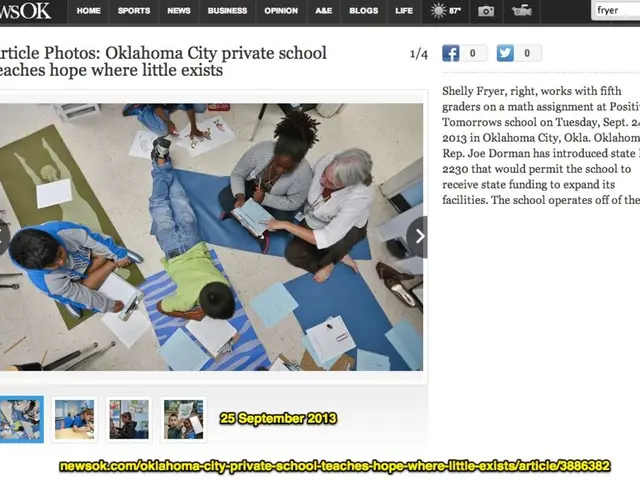Mental Health Exploration in Animation: Tracing the Pathway of Depression Awareness
"The Power of Depression Cartoons & Comics: Portraying Mental Health, One Panel at a Time"
In today's world, visual storytelling holds a remarkable power - especially when it comes to addressing mental health issues, such as depression. The rise of depression cartoons and comics has revolutionized the way we discuss and perceive mental health, merging humor, relatability, and poignant insights into a unique blend.
In a time where attention spans are dwindling and information overload is the norm, cartoons and comics offer an easy-to-digest and engaging method of conveying complex experiences. They give us a glimpse into the lives of those battling depression, allowing readers to connect on a deeply personal level.
Depression, a widespread mental health issue that affects millions, has long been shrouded in misunderstanding and stigma. However, the growing presence of depression-themed visual art is helping change this narrative, one panel at a time.
A Look Back: The Transformation of Depression Cartoons
The story of depression cartoons is an interesting one, continually evolving alongside societal attitudes towards mental health. In the past, mental health depictions in cartoons were often oversimplified, stereotypical, or even offensive. These representations often served as comic relief or portrayed mental illness in a negative light.
As our understanding of mental health has grown, so too has the sophistication and sensitivity of its portrayals in cartoons. A shift towards more nuanced and relatable depictions has been driven by artists who have experienced depression themselves or have close connections to those affected.
Notable figures in the genre, like Allie Brosh (creator of "Hyperbole and a Half") and Matthew Johnstone (creator of "I Had a Black Dog"), have made significant contributions by sharing their personal experiences and shedding light on the realities of living with depression.
Depression-themed Comic Strips: A Deep Dive
Sequential art pieces, known as depression comic strips, offer a unique opportunity to delve into the intricacies of depression over time. Effective strips often embody characteristics like honesty, vulnerability, balanced humor, and a nuanced portrayal of depression.
The immediate impact of depression-themed comic strips on readers' understanding and empathy is profound. They immerse readers in the lived experiences of those dealing with depression, offering a shared language that fosters empathy and connection.
The Digital Age Echo: Depression Cartoon Blogs
The digital age has given rise to a new platform for depression cartoons: blogs. These platforms have become hubs for artists to share their work and for readers to find relatable content. Famous depression cartoon blogs like "The Latest Kate" (by Kate Allan) and "Robot Hugs" (by Erin Human) have garnered large followings and fostered supportive communities.
The Therapeutic Influence of Visual Storytelling
Depression cartoons have proven to be effective tools for self-expression and healing. The act of translating personal experiences into artistic form can help individuals process difficult emotions, leading to greater self-awareness and progress in the healing process.
)Creating Impactful Depression Cartoons
Creating engaging depression cartoons requires a delicate balance of artistry, empathy, and authenticity. Key elements include relatable characters, evocative visual metaphors, and a tone that acknowledges the seriousness of depression while offering moments of levity or hope.
A crucial balance when addressing mental health through cartoons is humor, which can offer coping mechanisms, accessibility, and shared experiences but must not trivialize depression.
Conclusion
Depression cartoons, comics, and blogs have emerged as powerful tools in the fight against mental health stigma. They offer unique stories and insights, reaching audiences in ways that traditional media may not. The future of visual storytelling in mental health awareness looks promising, with new mediums like virtual reality and social media content potentially opening up fresh avenues for exploring and understanding depression.
Ultimately, the rise of depression cartoons underscores the need for continued dialogue and destigmatization of mental health issues. Through relatable, accessible narratives, these visual stories are contributing to a world where mental health conversations can occur open-mindedly, empathetically, and without shame. Let's continue to harness the power of storytelling in shedding light on mental health and fostering a more compassionate society.
References
1.Brosh, Allie. (2013). Hyperbole and a Half. Simon and Schuster.2.Johnstone, Matthew. (2007). I Had a Black Dog. Constable & Robinson.3.Clay, J. Depression Comix. Retrieved from https://www.depressioncomix.com/4.Correll, Gemma. (2015). The Worrier's Guide to Life. Andrews McMeel Publishing.5.Allan, Kate. The Latest Kate. Retrieved from https://thelatestkate.tumblr.com/6.Human, Erin. Robot Hugs. Retrieved from https://www.robot-hugs.com/7.American Art Therapy Association. (2017). About Art Therapy. Retrieved from https://arttherapy.org/about-art-therapy/8.World Health Organization. (2021). Depression. Retrieved from https://www.who.int/news-room/fact-sheets/detail/depression9.National Institute of Mental Health. (2021). Depression. Retrieved from https://www.nimh.nih.gov/health/topics/depression10.Malchiodi, Carla A. (2011). Handbook of Art Therapy. Guilford Press.
- The transformation of depression cartoons throughout history reflects the growing understanding of mental health and the shifting societal attitudes towards it.
- Depression comic strips can serve as therapeutic tools by offering individuals a means to process their emotions, build self-awareness, and foster a sense of empathy and connection with others.
- In the digital age, depression cartoon blogs have gained popularity as platforms for artists to share their stories and for readers to find relatable content, fostering supportive communities and contributing to the destigmatization of mental health issues.







